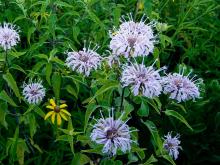Wildflowers, Grasses and Other Nonwoody Plants
Media

Species Types
Scientific Name
Teucrium canadense
Description
Like most other mints, American germander has square stems, opposite leaves, and two-lobed flowers. The unusual configuration of the corolla lobes is the key identifying characteristic.
Media

Species Types
Scientific Name
Agalinis tenuifolia (formerly Gerardia tenuifolia)
Description
Slender false foxglove, or common gerardia, is a small, showy wildflower with slender, opposite leaves and thin, wiry, branching stems. The small, funnel-shaped blossoms are pink or purple, with an upper lip that arches over the 4 hairy stamens.
Media
Species Types
Scientific Name
Salvia azurea
Description
Blue sage is easily identified by its wandlike clusters of sky-blue, two-lipped wildflowers. It blooms July–September in prairies, roadsides, and other open habitats.
Media

Species Types
Scientific Name
Glechoma hederacea
Description
Ground ivy, or creeping Charlie, is a creeping, nonwoody plant that often forms loose mats. A native of Eurasia, this member of the mint family has been introduced nearly throughout the United States. It is considered a lawn and garden weed.
Media

Species Types
Scientific Name
Scrophularia marilandica
Description
Eastern figwort occurs statewide in rich woods, woodland borders, and bottomlands. It’s usually 2-5 feet high, has square stems and lance-shaped, toothed leaves, and bears spreading clusters of small, green scoop-shaped flowers with brown petal lobes.
Media

Species Types
Scientific Name
Penstemon cobaea
Description
Cobaea beardtongue, or purple beardtongue, is probably Missouri’s showiest species of penstemon. Native to Missouri's southern Ozarks, it is grown statewide for its beauty, and because pollinators like it. It may be purple or white.
Media

Species Types
Scientific Name
Monarda fistulosa
Description
Sometimes called beebalm, wild bergamot (or horsemint) is a native mint with a long history as a valued Missouri herb. Some people make tea from it, but most of us enjoy its large, colorful flowers.
See Also
About Wildflowers, Grasses and Other Nonwoody Plants in Missouri
A very simple way of thinking about the green world is to divide the vascular plants into two groups: woody and nonwoody (or herbaceous). But this is an artificial division; many plant families include some species that are woody and some that are not. The diversity of nonwoody vascular plants is staggering! Think of all the ferns, grasses, sedges, lilies, peas, sunflowers, nightshades, milkweeds, mustards, mints, and mallows — weeds and wildflowers — and many more!





















